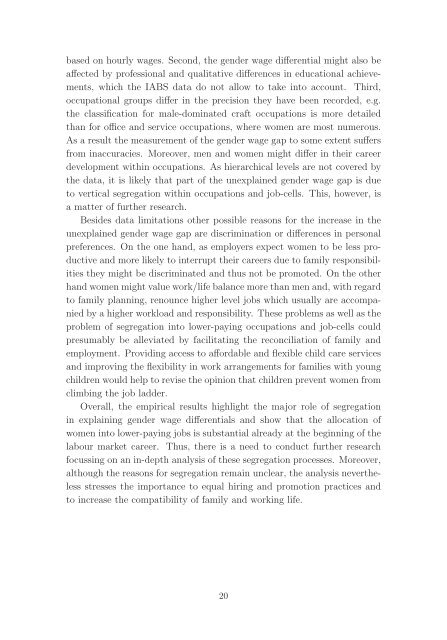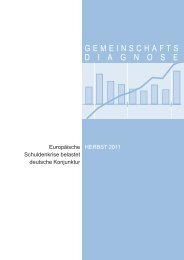Gender Segregation and Gender Wage Differences during the Early ...
Gender Segregation and Gender Wage Differences during the Early ...
Gender Segregation and Gender Wage Differences during the Early ...
Create successful ePaper yourself
Turn your PDF publications into a flip-book with our unique Google optimized e-Paper software.
ased on hourly wages. Second, <strong>the</strong> gender wage differential might also be<br />
affected by professional <strong>and</strong> qualitative differences in educational achievements,<br />
which <strong>the</strong> IABS data do not allow to take into account. Third,<br />
occupational groups differ in <strong>the</strong> precision <strong>the</strong>y have been recorded, e.g.<br />
<strong>the</strong> classification for male-dominated craft occupations is more detailed<br />
than for office <strong>and</strong> service occupations, where women are most numerous.<br />
As a result <strong>the</strong> measurement of <strong>the</strong> gender wage gap to some extent suffers<br />
from inaccuracies. Moreover, men <strong>and</strong> women might differ in <strong>the</strong>ir career<br />
development within occupations. As hierarchical levels are not covered by<br />
<strong>the</strong> data, it is likely that part of <strong>the</strong> unexplained gender wage gap is due<br />
to vertical segregation within occupations <strong>and</strong> job-cells. This, however, is<br />
a matter of fur<strong>the</strong>r research.<br />
Besides data limitations o<strong>the</strong>r possible reasons for <strong>the</strong> increase in <strong>the</strong><br />
unexplained gender wage gap are discrimination or differences in personal<br />
preferences. On <strong>the</strong> one h<strong>and</strong>, as employers expect women to be less productive<br />
<strong>and</strong> more likely to interrupt <strong>the</strong>ir careers due to family responsibilities<br />
<strong>the</strong>y might be discriminated <strong>and</strong> thus not be promoted. On <strong>the</strong> o<strong>the</strong>r<br />
h<strong>and</strong> women might value work/life balance more than men <strong>and</strong>, with regard<br />
to family planning, renounce higher level jobs which usually are accompanied<br />
by a higher workload <strong>and</strong> responsibility. These problems as well as <strong>the</strong><br />
problem of segregation into lower-paying occupations <strong>and</strong> job-cells could<br />
presumably be alleviated by facilitating <strong>the</strong> reconciliation of family <strong>and</strong><br />
employment. Providing access to affordable <strong>and</strong> flexible child care services<br />
<strong>and</strong> improving <strong>the</strong> flexibility in work arrangements for families with young<br />
children would help to revise <strong>the</strong> opinion that children prevent women from<br />
climbing <strong>the</strong> job ladder.<br />
Overall, <strong>the</strong> empirical results highlight <strong>the</strong> major role of segregation<br />
in explaining gender wage differentials <strong>and</strong> show that <strong>the</strong> allocation of<br />
women into lower-paying jobs is substantial already at <strong>the</strong> beginning of <strong>the</strong><br />
labour market career. Thus, <strong>the</strong>re is a need to conduct fur<strong>the</strong>r research<br />
focussing on an in-depth analysis of <strong>the</strong>se segregation processes. Moreover,<br />
although <strong>the</strong> reasons for segregation remain unclear, <strong>the</strong> analysis never<strong>the</strong>less<br />
stresses <strong>the</strong> importance to equal hiring <strong>and</strong> promotion practices <strong>and</strong><br />
to increase <strong>the</strong> compatibility of family <strong>and</strong> working life.<br />
20
















